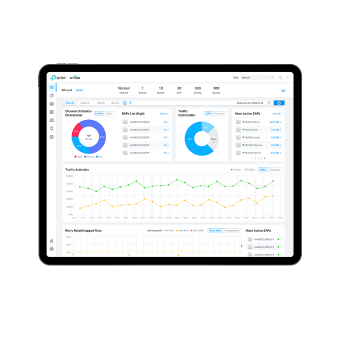How to Configure mDNS on the Omada Controller
This Article Applies to
Omada Controller V5.6 or above.
Overview
mDNS (Multicast DNS) Repeater can help forward mDNS request/reply packets between different subnets/VLANs. With this function, you can create a forwarding rule to allow the devices in the specified Client VLAN to discover the mDNS service in the specified Service VLAN. You can also specify the services to be forwarded.
Configuration
Please follow the configuration steps below to configure the mDNS repeater via the Omada SDN Controller v5.6 or later version.
1. Go to Settings > Services > mDNS
2. Click + Create New Rule to create a new mDNS forwarding rule.
3. Specify the parameters.
Name: Specify the rule name for identification.
Status: Enable or disable this rule.
Device Type: Specify the device type (AP or Gateway) for which the rule takes effect.
• Gateway
*mDNS support is added to Gateway since Omada SDN Controller v5.6, which requires both your Omada Router and Omada Controller upgrading to SDN 5.6.
The Gateway type doesn't support configuring Bonjour Service until Omada SDN Controller v5.8, which requires to upgrade the Router firmware to adapt 5.8.
• For Omada SDN Controller v5.6 or 5.7:

Network: Specify which network that mDNS request/reply packets can cross, that is, the range of services that can be found across networks/VLANs.
• For Omada SDN Controller v5.8 or later version:

Bonjour Service: Specify the services to be forwarded. (you can also create new Bonjour service types by click Manage Bonjour Service)
Service Network:
Network: Specify the network where the mDNS services are located.
Client Network:
Network: Specify the VLANs where the Client devices are located.
• AP
*mDNS support is added to AP since Omada SDN Controller v5.7, which requires both your Omada EAP and Omada Controller upgrading to SDN 5.7.

Bonjour Service: Specify the services to be forwarded. (you can also create new Bonjour service types by click Manage Bonjour Service)
Service Network:
VLAN: Specify the VLANs where the mDNS services are located. You can enter VLAN ranges or VLAN IDs separated by comma.
Client Network:
VLAN: Specify the VLANs where the Client devices are located. You can enter VLAN ranges or VLAN IDs separated by comma.
Note:
1) mDNS rules in AP type and Gateway type are mutually exclusive.
2) To make mDNS configuration take effect, please ensure both the AP/Gateway and Omada Controller are upgraded to the corresponding adapted firmware.
For example, to make the mDNS configuration in AP type work, ensure both your EAP and Omada Controller are upgraded to adapt to Omada SDN Controller v5.7.
¿Es útil esta pregunta frecuente?
Sus comentarios nos ayudan a mejorar este sitio.








